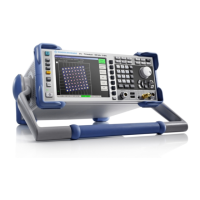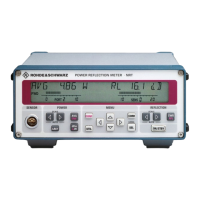Measuring the occupied bandwidth R&S FSH
1309.6275.12 4.42 E-2
Select the menu item TRIGGER DELAY by using
the rotary knob and confirm with the ENTER key
Using the rotary knob or the cursor keys, adjust the
t
rigger delay until the TDMA burst is inside the
vertical lines indicating the measurement range, or
Using the number keys, enter the appropriate
trigger delay and terminate the entry with the
appropriate unit key.
Measuring the occupied bandwidth
Ensuring the proper operation of a transmission network requires that all transmitters adhere to the
bandwidths assigned to them. The occupied bandwidth is defined as the bandwidth that contains a
specified percent of the entire power of the transmitter. In the R&S FSH, the power percent can be set
between 10 % and 99.9 %. Numerous standards require a percent of 99 %, which corresponds to the
default setting of the R&S FSH.
One of the measurement functions of the R&S FSH is the measurement of occupied bandwidth. After
the channel bandwidth has been entered, the R&S FSH automatically selects the measurement
parameters so that an optimal result is attained.
Operation:
Press the MEAS key.
Press the MEASURE softkey.
The R&S FSH will open the measurement function
menu.
Using the rotary knob or the cursor keys, select
OCCUPIED BW from the menu (highlighted in
red).
Confirm your selection with the ENTER key or the
MEASURE softkey.
The R&S FSH displays the softkey menu for setting the measurement of occupied bandwidth. Two
vertical lines in the measurement diagram indicate the occupied bandwidth. The measured numeric
value (OBW) is shown in large characters above the measurement diagram.
occupied
bandwidth
Standard
Occupied
Bandwidth
Channel
Bandwidth
Power
Percentage

